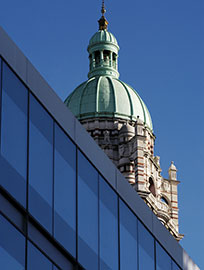Perfect symmetry – explaining the patterns in everyday life

Oxford mathematician speaks at Imperial - News
See also...
By Danielle Reeves
Wednesday 13 February 2008
The secrets of symmetry found in nature, art, music and architecture were the focus of a special lecture at Imperial College London this week, delivered by renowned Oxford mathematician, Dr Marcus du Sautoy.
Dr du Sautoy spoke to a large audience of all ages about the "magic trick moves" of symmetry which can be performed on a shape or object, leaving it looking untouched.
As the audience discovered, there is a lot more to symmetry than mere mirror-images, and symmetry is found in the most unlikely of places. Dr du Sautoy began by revealing his childhood fascination with the language of mathematics: "A secret language, a coded language" is how he thought of maths as a child and, spurred on by his dreams of being a secret agent or spy like James Bond, he set about cracking this code.
Going on to explain his current fascination with the area of mathematics concerned with symmetry, Dr du Sautoy explained that it has a language and code all of its own, which can perhaps be seen most clearly in the role it plays in the natural world.
"Symmetry is the way that plants and animals communicate," he said. "It is an indication on meaning in the natural world."
To illustrate this point, Dr du Sautoy cited the example of a bumble bee, which has very poor vision, but which can recognise symmetrical shapes – which means bees are drawn to the symmetry of flowers, enabling them to carry out their key role in pollination and plant reproduction.
Countless other examples of symmetry exist in nature. Dr du Sautoy highlighted the way in which it is a signal of "good genes," hence the reason people with more symmetrical faces are often perceived to be more attractive, and why eggs from free range hens tend to be symmetrical, whereas those from battery hens do not.
Symmetrical shapes are also found at the molecular level, with viruses including AIDS and the herpes virus being symmetrical in shape, and in the arts, with music and architecture often drawing on the idea of symmetry for inspiration and design.
The second half of Dr du Sautoy's lecture explored the complex study of symmetry that mathematicians have been carrying out since the pioneering work of a young Frenchman, Evariste Galois, who began to devise a "mathematical language" to explain symmetry before his untimely death in a dual in 1832.
Dr du Sautoy's own work is focused on analysing different groups of symmetries, specialising in particular on their relationships with one another, building on a seminal book called 'Atlas,' published in the 1980s, which Dr du Sautoy described as being like a "periodical table," explaining how different types of symmetry interact and are related to each other.
In his closing remarks, Dr du Sautoy emphasised the extent to which there is still lots to be learned in this fascinating field. "The fact that there are unsolved problems in maths keeps it a living subject," he said.
The lecture was organised by the Royal Institution and Harper Collins, publishers of Dr du Sautoy's new book, 'Finding Moonshine: A Mathematician’s Journey Through Symmetry.'
-Ends-
Article text (excluding photos or graphics) © Imperial College London.
Photos and graphics subject to third party copyright used with permission or © Imperial College London.
Reporter
Press Office
Communications and Public Affairs
- Email: press.office@imperial.ac.uk
